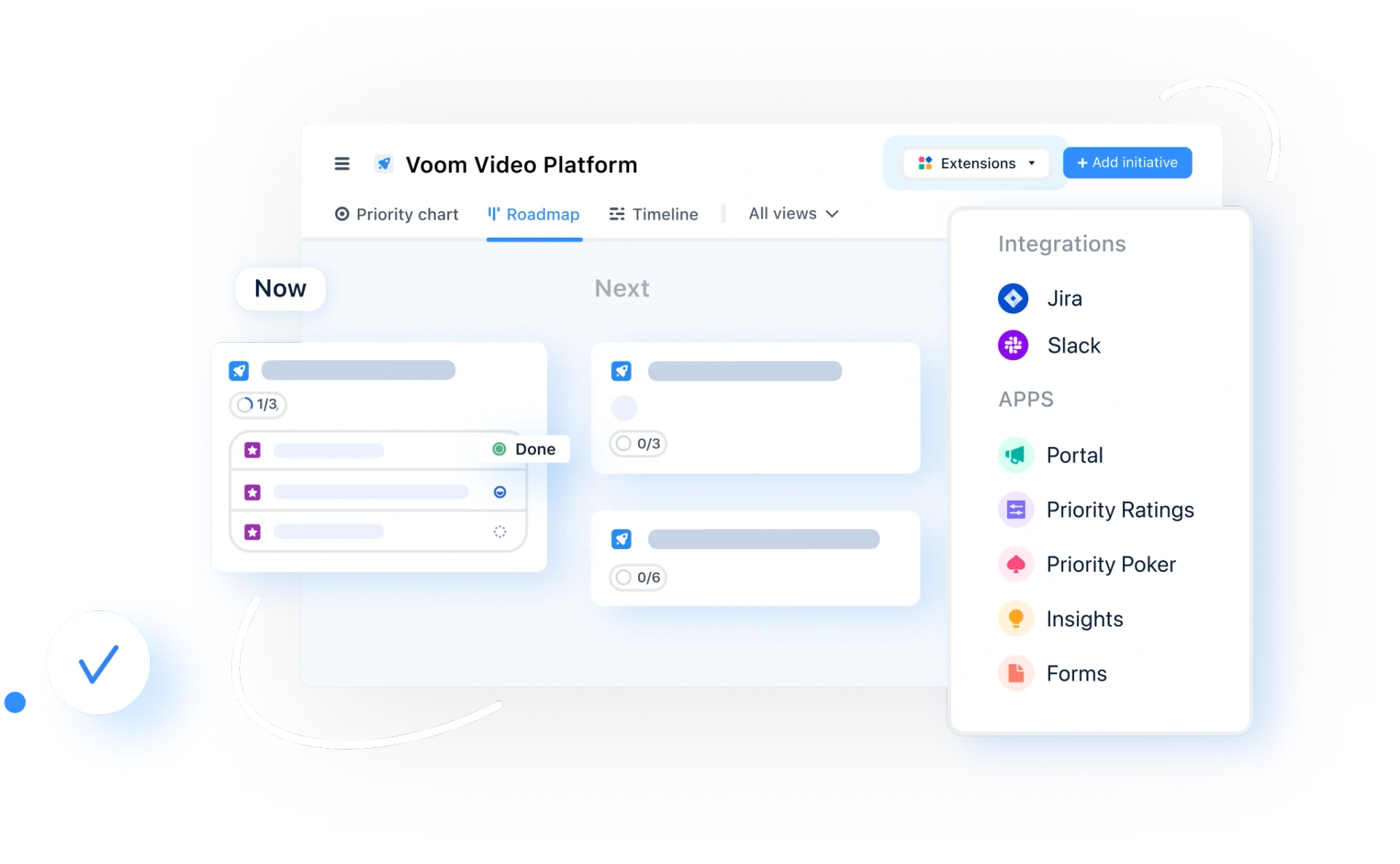Six Thinking Hats
Product teams have a clear product vision and will work tirelessly to reach it. However, a tunnel-vision approach often leads to a closed-off development process that fails to address the needs of different users. The Six Thinking Hats framework helps us to introduce alternative perspectives and build a product that offers value to a wide audience.
The first time you run the Six Thinking Hats technique in your retrospective will take a little longer than usual, but you’ll find your product team is far more engaged in the process. Plus, it helps uncover a wider range of perspectives to guide your next sprint.
In this article, we’re going to deep dive into using the Six Thinking Hats in product management to discover how it can elevate your products and how airfocus can help.
What are the six thinking hats? (and why product leaders are revisiting them)
Definition of the six thinking hats
The six thinking hats is a method used to amplify creative conversations, by making sure that a broad variety of viewpoints and thinking styles are represented. Using six roles (or "hats"), the framework — developed by Dr. Edward de Bono — allows teams to more easily structure abstract thinking for productive results.
The Six Thinking Hats is a structured thinking framework that helps product teams approach complex decisions from multiple perspectives. Originally developed by Edward de Bono, the model introduces six distinct “hats,” each representing a mode of thinking. Teams are guided to adopt these thinking styles one at a time. This supports parallel thinking and improves decision quality.
Here’s a breakdown of the Six Thinking Hats:
White Hat: Focuses on facts, data, and available information. What do we know? What do we still need to find out?
Red Hat: Explores intuition, emotion, and gut reactions. How do people feel about the situation?
Black Hat: Highlights risks, obstacles, and potential problems. What could go wrong? What should we be cautious about?
Yellow Hat: Looks for value, benefits, and positive outcomes. What’s the potential upside?
Green Hat: Encourages creativity and alternative ideas. What new solutions or perspectives could we explore?
Blue Hat: Manages the thinking process itself. Are we following the right steps? How should we organize our discussion?
It’s important to note that the Six Thinking Hats are not tied to personality types. Anyone can wear any hat. The goal is to guide collective thinking, not categorize individuals.
Why structured thinking matters in complex product organizations
The more complex your organization gets, the more chaotic it can be. Structured thinking can help restore alignment and ensure that decisions are grounded in clarity, context, and a shared understanding. Here are just some ways structured thinking matters:
Avoiding groupthink in product discovery
Groupthink is one of the most common routes to failure in product discovery. Teams often latch onto early ideas and fail to challenge their assumptions. Biases go unchecked, user insights are selectively chosen, and alternative paths are overlooked.
Using the Six Thinking Hats in product management and product discovery helps create deliberate checkpoints for re-evaluating assumptions. For example:
Start with the White Hat to ground the conversation in current data and customer insights.
Shift to the Red Hat to surface emotional responses or intuition from team members.
Use the Green Hat to generate alternative approaches based on the conversation you’ve had.
Conclude with the Black Hat to stress-test the proposed solutions and anticipate potential failures.
This structured flow of perspectives helps avoid tunnel vision and encourages deeper interrogation of both the problem and proposed solutions.
Creating space for dissent and creativity in roadmap reviews
When teams become locked into delivery mode, dissent and critical thinking are often viewed as distractions. But ignoring risks and alternatives during roadmap planning can lead to costly mistakes down the line.
Here are some examples of how the Six Thinking Hats can be applied during a roadmap review:
Black Hat thinking forces the team to consider risks, technical constraints, and potential failure points. It helps temper overconfidence and exposes blind spots.
Green Hat thinking brings in fresh perspectives. It encourages teams to ask, “Are we building the right thing?” or “Is there a better way to solve this?”
Yellow Hat keeps optimism in the picture, helping balance risk with reward and reminding teams of the broader value their roadmap is designed to deliver.
Managing strong opinions without losing velocity
Product leaders often sit at the intersection of marketing, engineering, design, and leadership. Each group comes with its own priorities, metrics, and perspective on the project. Unfortunately, this can lead to miscommunication, misalignment, and conflict that slow down development. The Six Thinking Hats helps product leaders contain those discussions without suppressing valuable input.
The Blue Hat plays a key role in facilitating this process. It ensures the discussion stays on track, time-boxed, and relevant.
Participants feel heard, even if their view does not carry the final decision.
Strong opinions are acknowledged, but within boundaries that keep the conversation productive.
Rather than opening the floor to unstructured debate, leaders can guide participants through the Six Hats in sequence. This creates a controlled environment where each type of thinking gets its moment, and everyone contributes within a shared framework.
Practical ways product leaders can apply the Six Hats
Product leaders can apply the Six Thinking Hats framework at many points throughout the product development process. This helps avoid tunnel vision and keeps discussions open. Let’s look at some examples of where a product leader may want to use the Six Hats.
In roadmap planning workshops
Roadmap planning is one of the most strategic activities product leaders facilitate. It can also be one of the most emotionally charged. The Six Thinking Hats helps remove personal bias from the process and ensures that all options are considered before committing to priorities.
Use the White Hat to present the data, including user feedback, market trends, and effort estimates.
Apply the Red Hat to gauge stakeholder sentiment and internal momentum.
Encourage Black Hat thinking to assess feasibility, dependencies, and known risks.
Introduce Yellow Hat to highlight the potential upside of key initiatives.
Bring in Green Hat to explore other ways to achieve the same outcome.
Close with the Blue Hat to organize next steps and decisions.
In product discovery or ideation sessions
The early stages of product development benefit enormously from customer feedback, but they also require structure to ensure ideas stay anchored in user needs and business goals.
Here’s how you can structure a discovery session with the Six Thinking Hats:
Begin with the White Hat to review user research, customer feedback, and usage analytics.
Shift to the Green Hat to generate new solutions or unexpected angles.
Use the Red Hat to explore initial reactions to those ideas. What feels promising? What seems risky?
Finally, use the Black Hat to identify weak points, constraints, or deal-breakers.
In prioritization debates
Product prioritization is a constant challenge in product management, which can easily lead to conflict. The Six Thinking Hats provide a framework for everyone to approach project priorities objectively.
White Hat thinking helps clarify impact and effort based on available data.
Black Hat flags areas of high risk or uncertainty.
Yellow Hat offers a reminder of long-term value or strategic upside.
Red Hat gives space for instinct and user empathy.
Green Hat can spark creative alternatives to high-effort features.
Blue Hat ensures the conversation leads to a clear next step.
In OKR and goal-setting discussions
Setting objectives and key results should be a strategic act, not an administrative one. The Six Thinking Hats can make OKR discussions more thoughtful and engaging.
In these conversations:
Start with the White Hat to assess what the data tells you about performance and trends.
Move to the Red Hat to gather emotional responses to proposed goals. Do they feel achievable? Do they inspire action?
Use the Black Hat to challenge the assumptions behind stretch goals or timelines.
Introduce the Yellow Hat to articulate the value behind the goals.
Let the Green Hat explore innovative approaches or new KPIs.
Close with the Blue Hat to finalize structure, cadence, and ownership.
Making the Six Thinking Hats actionable in your product org
The value of the Six Thinking Hats in product management lies in how consistently you apply the framework. Without structure, the model becomes just another brainstorming tool. Product leaders need to operationalize the technique across meetings, rituals, and decision-making processes.
Here are some ways to embed the Six Hats in your organization:
Use templates: Structure meetings around the Six Hats with pre-defined prompts or agenda templates. airfocus’ AI Assist can also help by automatically generating prompts that fit your discussion.
Use collaborative tools: Use collaborative docs, comments, and digital whiteboards to run Six Thinking Hats exercises with distributed teams.
Rotate hats intentionally: Assign team members hats that contrast with their natural perspective. This encourages empathy and critical thinking.
Turn it into a ritual: Introduce a Hat rotation in retrospectives, backlog grooming, or quarterly planning cycles. The more often you use it, the more value the Six Hats can offer.
Incorporate into written proposals: Ask stakeholders to present their business cases using the hats to pre-empt objections and deepen analysis.
Help your team think in parallel, not in conflict
Product leaders rarely suffer from a lack of ideas or opinions. The challenge is moving from discussion to decision without sacrificing clarity, creativity, or buy-in.
The Six Thinking Hats is a model built for this reality. It invites teams to explore all sides of a decision without collapsing into conflict. It provides structure for dissent, space for creativity, and a shared language for complex collaboration.
If your team struggles with alignment, stalls in prioritization, or repeatedly revisits the same decisions, this is a technique worth adopting.
Book an airfocus demo today to see how easy it is to incorporate the Six Thinking Hats into your product planning.

General FAQ

Glossary categories
Experience the new way of doing product management

Experience the new way of doing product management








